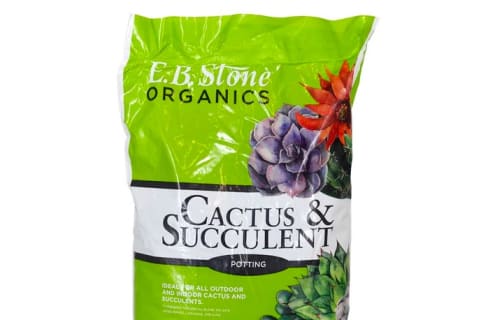Advertisement
The Best Types Of Soil For Succulents + A DIY Recipe Your Plants Will Love

There's nothing succulents hate more than being overwatered, which is why soil can make or break these drought-adapted plants. Here's how to choose a perfectly airy mix for your garden or houseplants—whether you buy it at the store or opt to make your own.
What type of soil is best for succulents?
Most succulents come from dry, hot areas, and they've adapted to store water in their leaves, stems, and roots. They're used to going a long time without water. "They also don't usually come from areas with very nutrient-rich soils," adds Rachael Cohen, a succulent artist and the author of Everyday Plant Magic.
This means that unlike tropical plants (pothos, philodendron, etc.) that prefer slightly damp soils stuffed with lots of organic materials from decaying bark and leaves, succulents hail from very dry soil that is higher in inorganic materials like rock. That's what you're looking to recreate when keeping succulents at home.
What to look for in a soil.
Cohen explains that the perfect soil mixture for succulents is coarse, gritty, and porous, with lots of little nooks and crannies. It's also light and airy, allowing water to drain through it quickly and completely.
Here are a few of the materials that you'll find in a well-balanced succulent mix:
- Activated charcoal
- Coarse sand (Not the kind from the beach! That will be too salty.)
- Coconut coir
- Gravel
- Pebbles
- Perlite (volcanic glass)
- Pumice (pulverized volcanic rock)
If you're buying a premade mix, be sure to look for one that is specifically for succulents or cactuses. An all-purpose potting or garden mix will hold on to too much moisture and increase your risk of overwatering.
E.B. Stone and Espoma make two of Cohen's favorite organic blends:
DIY recipe for succulent soil.
Making your own mix is also an easy and affordable option, and it allows you to customize your soil based on your conditions and the type of succulents you're growing.
While Cohen usually opts to buy premade soil, she says the following DIY mix can be great for plants too. The basic recipe uses any old potting or garden soil you have lying around and pumice—Cohen's favorite inorganic material for succulent mixes because it's light, airy, and allows for proper drainage.
She notes that the key to making your own succulent mix is including enough of those inorganic materials like pumice, coarse sand, gravel, or perlite. If your soil has too much organic material, it won't have enough aeration and it could effectively drown your plants.
Follow the step-by-step process below for planting your succulent in a mix that will feel just like home.
Ingredients:
- 1 part all-purpose soil or compost
- 1 part pumice
- Coarse sand, gravel, or perlite (optional add-in—more on that below)
- A succulent
- A pot if using one (make sure it has a drainage hole)
Method:
- Add your soil, pumice, and optional amendments to a bowl or tray and stir until combined. The mix should look and feel very light and have plenty of air pockets.
- Gently shake your succulent pant to loosen any existing soil around its roots.
- Plant your succulent in your new soil mix. If planting in a pot, you might need to cover the drainage hole with mesh or clay to ensure that soil doesn't fall out the bottom.
- Pack your soil around your plant just enough so that it stays in place. Be careful not to pack it down too much, as you want to keep those air pockets intact.
Those who live in cold, wet climates will likely need to add more dry materials to this mix for some extra draining. Those who live in hot, desert environments should be OK with a 50/50 mix. Every type of succulent has slightly different soil and water preferences, so keep an eye on how your plant is doing and adjust as needed.
Tips to keep in mind.
Here are some final tips to help make sure your succulent is happy in its new soil:
- Since succulents adapted to last a long time without rain, they prefer less frequent waterings. Give yours a good soak every few weeks instead of a little sprinkle every few days.
- Don't put your succulent in a pot without a drainage hole. Without a place for water to escape, its soil will get too moist.
- When you water your succulents, the water should quickly sink down into the soil and come out the bottom of the drainage hole. If you notice that water is sitting on top of your soil, your mix is likely too compact and could use some more pumice or gravel to loosen it up.
- If your succulent is happy with its soil and moisture levels, Cohen says its leaves will look plump and full. If they appear squishy, mushy, and brown, it's a sign that your plant is getting too much water and/or its soil isn't draining properly. If they are dry and easy to break off, your plant might not be getting enough water.
The takeaway.
Sun-loving succulents can be pretty forgiving plants, but they do require special soil. Be sure to place yours in a mix that has plenty of fast-draining inorganic materials to help it live a long, healthy life.

